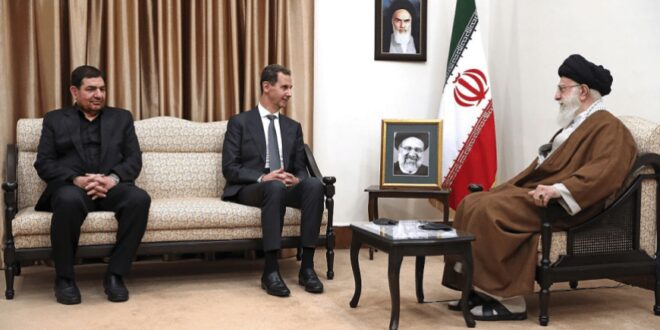The Assad regime is clearly embarrassed, particularly since the start of the Gaza war, Adnan Ali writes in Syria TV.
The war in Gaza has highlighted a gap within the axis of resistance led by the Syrian regime under Bashar al-Assad, which chose to distance itself from the axis’ approach to this war, aiming to avoid any negative repercussions on its regime. This has, according to many observers, sparked a “silent crisis” within the axis, the outcome of which remains uncertain.
In his recent speech, Hezbollah Secretary-General Hassan Nasrallah was careful to absolve the Assad regime of blame, justifying its restrained stance by stating that Syria is still at war, with its army spread across many fronts, and is not required to engage in the war against Israel, but merely to offer political support.
It is difficult to believe that Nasrallah’s words are entirely sincere, especially given the regime’s response to his speech. For the second time in a row, unlike with previous speeches, Syrian media did not broadcast Nasrallah’s remarks, indicating the regime’s discomfort.
The Assad regime is clearly embarrassed, particularly since the start of the Gaza war. This is not only due to its absence from the “unity of squares” within the axis of resistance but also due to its failure to respond to aggression against it, despite its non-involvement in the current war and its ongoing refusal to retaliate against numerous Israeli airstrikes on Syrian territory in recent months.
Media leaks suggest that the regime has received advice from Arab and Russian sources since the early days of the war to avoid engaging with the Iranian axis for its own safety, as Israel’s response would likely target the regime itself rather than Iranian assets in Syria, should it support the axis or allow Syrian territory to be used for operations against Israel.
Recent events, such as the assassination of Hamas leader Ismail Haniyeh and Hezbollah leader Fouad Shukr, and the subsequent threats of retaliation by Iran and Hezbollah, have again tested the Damascus regime. The potential for a regional war could force the regime to abandon its neutral stance, at least to a minimum extent.
Assad Under Test
This situation poses a critical test for the Assad regime. If the confrontation escalates and continues, it may be compelled to participate, possibly under pressure from Iran and Hezbollah, though not to the point of jeopardizing the regime’s survival. The regime has become the weakest link in the axis, as Israel is unlikely to engage in an open war with distant Iran or with Hezbollah, which is engaged in guerrilla warfare without the burden of a state to protect. Unlike the regime in Damascus, which has spent years depleting its strength fighting the opposition and its people, its primary concern remains to cling to power.
These developments suggest that Iran might consider working directly with units or commanders loyal to it within the Syrian army, bypassing those aligned with Russia, should they need to use Syrian territory in their confrontation with Israel. Recently, there have been reports of a secret visit by the Syrian army’s chief of staff to Iran, allegedly without Assad’s knowledge, to coordinate such efforts. This could indicate further internal fragmentation within the regime’s institutions, particularly the military, between Iranian and Russian loyalties.
While the Assad regime’s role within the alliance appears to be declining, the Houthis in Yemen have emerged as active participants. However, Yemen is distant from the primary conflict zone and may serve other roles, such as pressuring Iran’s Arab adversaries, particularly Saudi Arabia, and preventing them from joining any regional alliances against Iran.
 Eurasia Press & News
Eurasia Press & News


